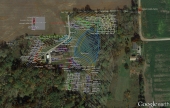





































I never fail. I don't believe in it. I only succeed at finding what doesn't work.




Seed the Mind, Harvest Ideas.
http://farmwhisperer.com








jdwheeler42
http://goingupslope.blogspot.com/




Brenda
Bloom where you are planted.
http://restfultrailsfoodforestgarden.blogspot.com/

|
When all four tires fall off your canoe, how many tiny ads does it take to build a doghouse?
Learn Permaculture through a little hard work
https://wheaton-labs.com/bootcamp
|







